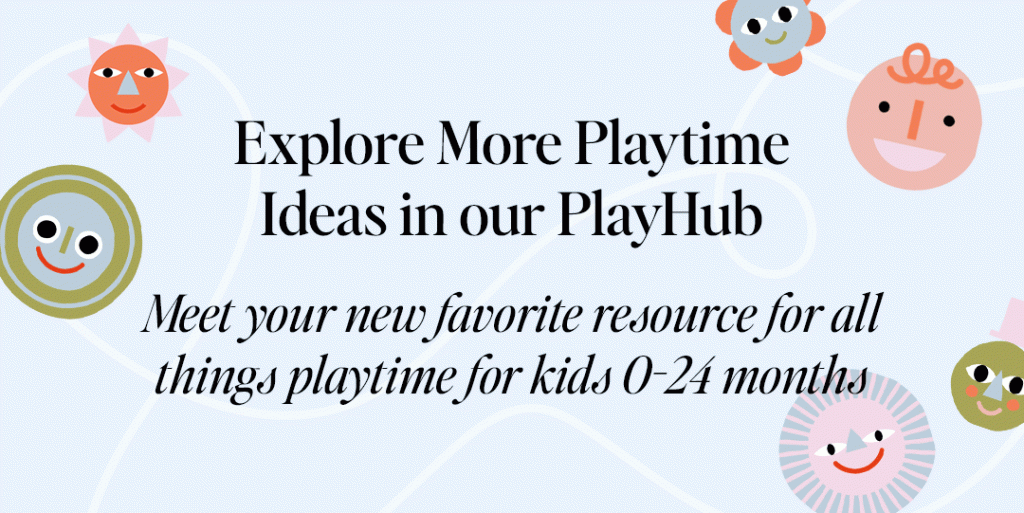The foundation of taking a turn is the skill of waiting, which requires and builds self-control. Children under 3 are typically and developmentally expected to engage in parallel play, when each child is engaged in their own activity next to the other. The norms of this age group allow for the child to feel ownership over what they are working with, until they have exhausted the toy and are ready to move on. As adults, imagine if you were working on the computer and then suddenly asked to “share” with a coworker. While sharing might feel unnatural, teaching your child how to take turns and how sharing affects others is a skill we can begin modeling early on in toddlerhood.
Children 7-12 months are just beginning to explore physically, their language may be developing and they are aware of their surroundings. As they begin to interact with objects in their environment, parents and caregivers can introduce the concept of taking turns. If your child is in a household with other children, or in a childcare setting with others, it may become more prevalent at an early age.
Your child will benefit from practicing with you and seeing your patience modeled. Here are some ways to begin:
Introduce the Language of Turn Taking
Before a child turns one, you can begin to introduce the language of waiting early on in a clear and short manner. My turn, then your turn. And ask your child, May I have a turn? As your child’s language is still developing, they are in tune and absorbing everything they hear. Beginning to introduce the concept early and with repetition will set your child up for success when they may begin play dates or other forms of socialization.
Games and Role Playing
Role playing and turning it into a game is another fun way to introduce the concept of taking turns. Handing a stuffed animal back and forth can be an easy way to use the aforementioned beginner language and show your child how to wait. Repeat the words over and over again so each time the stuffed animal is placed in their hands, they hear your turn. Children learn quickly and they will begin to make the association.
As they grow and their language development expands, you can also introduce turn taking in conversation. It is my turn to say something, I notice that the sky has clouds in it. Now it is your turn, what would you like to tell me? Depending on your child’s language development, you can listen closely and respond to what they are trying to tell you. Responding right away will signal to your child that you want to keep the conversation going and what they are telling you is important.
Use Songs and Countdowns
Sing a song or try some counting to wait for a turn. If your child is at a playdate and another child wants to play with his truck, you can invite the children to sing a song to mark the time limit for the toy. Hearing a song will give a clear marker and also furthers their ability to wait. It can help them to predict when their turn will end or begin and makes it less likely that they will become frustrated and use challenging behavior. “I see you want a turn with the truck too. Let’s sing a song and when we are done it will be your turn. Should we sing the Itsy-Bitsy Spider or Twinkle, Twinkle Little Star?”
A sand timer or a countdown clock is also a visual way for your child to practice with siblings at home, or with other children.
Distract and Redirect
When waiting becomes too hard, offer distractions. Young children need to stretch this ability to wait and it can be frustrating. If your child is waiting for a toy, place something else in front of him as an alternative. Or, removal from the situation can help too. “I can see waiting for the truck is hard, let’s try out the slide while we wait.” Remember that even if your child doesn’t have the language skills, your words are being understood, so talking them through any situation will help.
As your child is growing older and stretching their ability to wait, suggest options that may distract for the moment. “There are other toys we can play with while we wait. Would you like to try the puzzle or the ball track while we wait for the truck to be available?” Or waiting in another place with a change of scenery can offer distraction that your child may need to practice self control. “It looks like Chloe is still working with the bucket, let’s go over to the slide while we wait.”
Acknowledge Frustration and Celebrate Successes
This is a hard skill to learn! Acknowledge your child’s feelings and celebrate their successes. “It can be so frustrating to wait for so long, I see how much you want to play with the truck.” And after a successful moment of waiting or giving a toy to a friend, “I love the way you and Jack took turns on the swing.”
This is a hard skill to learn and takes time and practice. Acknowledge your child’s feelings and celebrate their successes. Thank you for giving me a turn! It was hard to share that truck with Jack, but I loved how you tried!



 "
"
